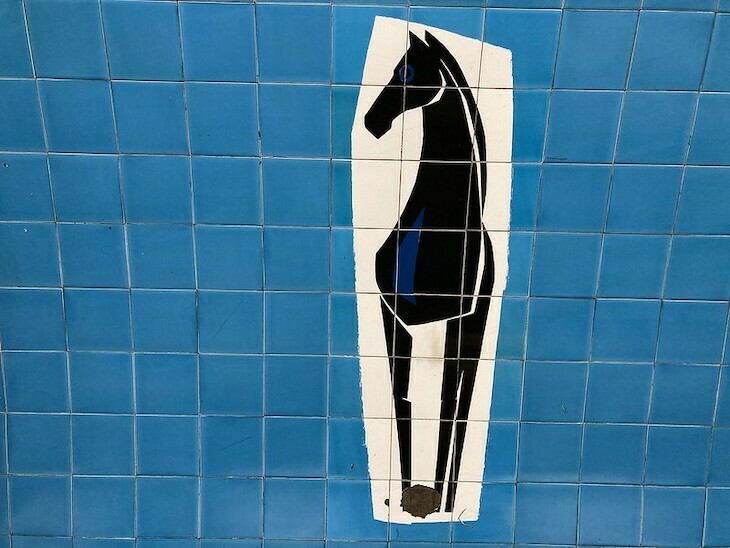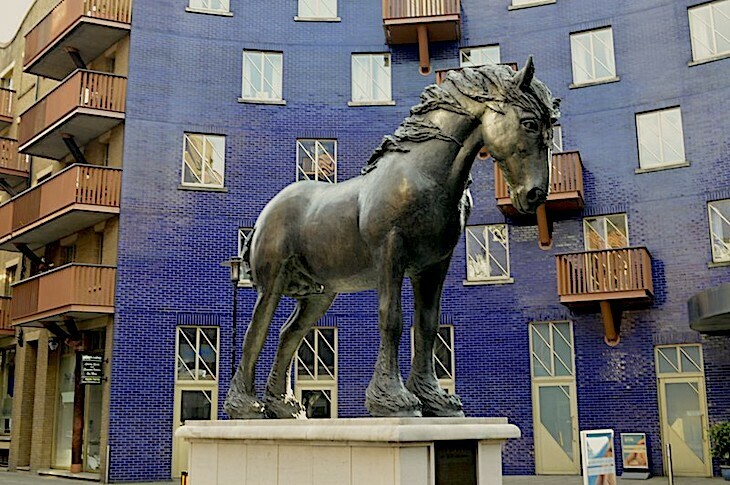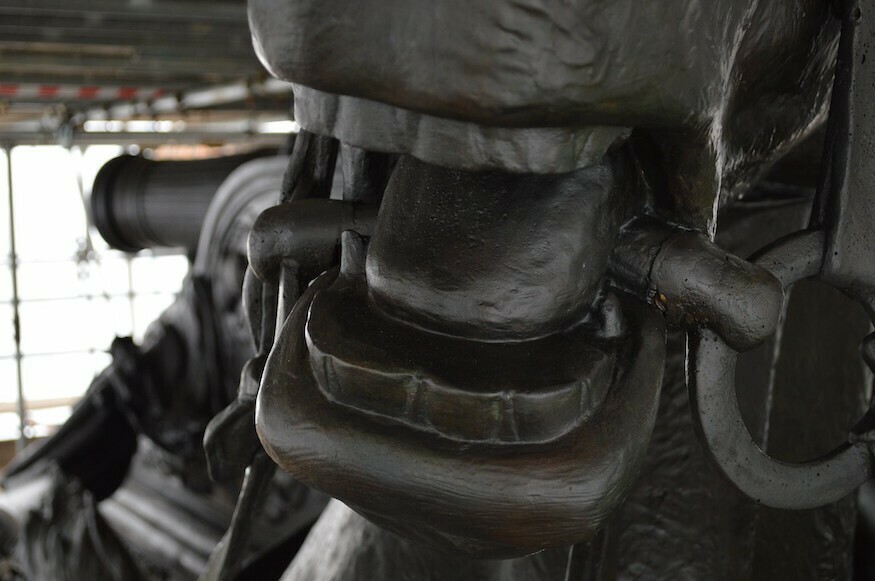
Horses were once as common as muck (and caused most of it, too). Nowadays, they’re so scarce that many of us would fire up Instagram at the sound of approaching hooves.
Real life horses might be a rarity in London, but their legacy lives on through countless statues and murals. Here are some of our favourites, spotted on a canter round town.
See also: Around London in 12 elephants – Around London in 12 dragons – Around London in 13 tigers – Around London in 11 swans
1 and 2. Blackhorse Road beauties

The Victoria line tube station features two arty horses. The one shown above — a combo of mosaic and relief sculpture — decorates the outside of the building. All Victoria line stations feature site-specific tile patterns at platform level and those at Blackhorse Road feature… a black horse.

3. Whitechapel Gallery weather vane

Where in London can you see a sculpture of Erasmus sitting backwards on a horse? It would be an interesting question had we not already revealed the answer above. The rear-facing theologian has adorned the roof of the Whitechapel Gallery since it was extended into a neighbouring library building in 2009. The gallery’s original plans called for an ornate weather vane but, for reasons unknown, it was never added. Over 100 years later, sculptor Rodney Graham was commissioned to correct that oversight. His curious creation references a legend that Erasmus would use lengthy rides to get a bit of writing done. Why he’s perched backwards is open to interpretation.
4. Two-dimensional horse in Mile End

You’ve probably seen these 2D steel sculptures in other locations around town. They were installed by cycling charity Sustrans and usually reflect local personalities or heroes (see the complete list here). One of the trio in Mile End Park, however, commemorates the canal horses which were once a common sight here and elsewhere on the waterways. The russet hoofster is accompanied by statues of Sylvia Pankhurst and footballer Ledley King.
5. The Huntsman statue of Croydon

Arguably London’s oddest equestrian statue hides around the side of an office development in Croydon (south side of George Street near East Croydon station). I think we’d all agree that it’s visually unusual. How many sculptures of horses leaping over hedges do you see? But the subject — fox hunting — is also a curious one to celebrate in a public work of art. According to the always-diligent Footprints of London team, the inspiration here is literary. The sculpture shows the character John Jorrocks from the books of Robert Surtees racing to reach the Surrey Hunt at Croydon. The site’s developer Paul Waite was fond of Surtees and commissioned sculptor John W Mills to create the piece in 1982.
6. Horses in fountains, Aldgate

Croydon doesn’t have the only horse sculpture commissioned by developers. The Goodman’s Field development near Aldgate East contains a veritable stampede. Six bronze horses (all different breeds) can be found mucking about in the fountains, each sculpted by animal specialist Hamish Mackie. The work is site-specific; the area was once noted for its horse pastures, as noted by 16th century chronicler John Stow.

Developer-led art often comes in for a bit of a bashing, but this commission is truly successful and worth seeking out if you’re in the area.
7. The stumbling king, St James’s

London contains dozens of equestrian statues showing royalty, nobility and military figures. This list would soon get boring were I to catalogue them all. One that stands out, however, is the equestrian statue of William III in St James’s Square. The horse’s rear hooves are attached to a small supporting mound that might easily be dismissed. It represents* the most momentous mole hill in history (admittedly from a very short list). While out riding in 1702, William’s horse stumbled over such a mound, throwing the king who then fractured his collar bone. Complications led to pneumonia which eventually killed him. Opponents of the king would later toast “the Little Gentleman in Velvet” who brought about his downfall. It’s one of the older equestrian statues in London, dating back to 1808.
*Possibly. This is one of those London ‘facts’ for which hard evidence is hard to come by.
8. Horsey pubs

After rubicund lions, horses must surely be the most popular animal to feature on pub signs. Some of London’s finest have equine appellations, including The White Horse in Parson’s Green (dubbed the ‘Sloaney Pony’), Soho’s legendary Coach and Horses and the Flying Horse, which is the only pub on Oxford Street. The one shown in our photo is the excellent Black Horse in Barnet, which though a great place for humans, is not approachable by horse.
9. East Finchley’s upcycled horse

Here’s a steed that deserves to be better known. This magnificent beast, assembled from cogs, bike chains and other mechanical parts, stands in front of the Engine Rooms events space and Hexagon car showroom in East Finchley. It’s a very clever bit of upcycling, though we can’t find any information about the craftsperson behind it.
10. Jacob the Horse, Bermondsey

One of London’s beefiest horse statues lurks in a residential area just south of Shad Thames. Dubbed Jacob (after the nearby Jacob’s Island, a long-vanished slum depicted in Oliver Twist), the horse represents the dray horses that were once stabled at the Courage Brewery hereabouts. It was sculpted by Shirley Place and reportedly lifted in by helicopter in 1987.
11. And the real horses of London

As we said up top, horses are now a rarity in London, but they never entirely vanished. Most famously, Horse Guards in Whitehall is home to London’s most-photographed steeds, and a police stables nearby make this part of town particularly cloppety. A few businesses still use horses to pull wagons, though these are usually for heritage or novelty value.

Horse riding is also a common sight in many of the Royal Parks. London’s many city farms usually house a horse and you can take to the saddle at a surprising number of London-based stables.
